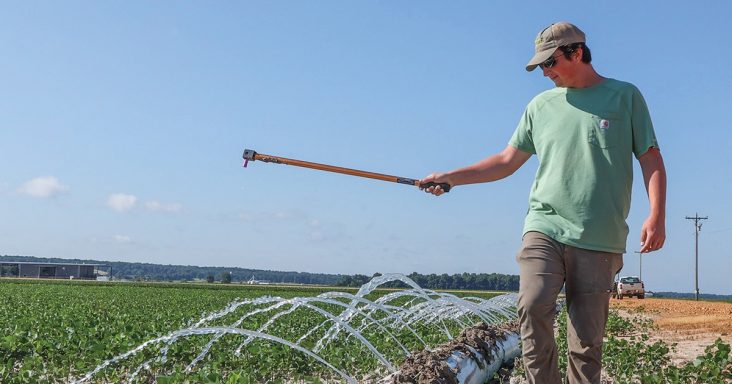Arkansas’ rice crop poised for back-to-back years of expansion
by May 2, 2024 7:45 am 173 views

Rice Research Center in Newport. Photo courtesy of UA System Division of Agriculture. @AginArk
Arkansas’ rice crop rebounded in terms of acres in 2023, with farmers adding 327,000 more acres than they planted in 2022. The U.S. Department of Agriculture (USDA) reported that the 1.41 million acres harvested in the state last year was roughly half the rice grown in the country.
During the past decade or more, it has been rare for Arkansas rice producers to have back-to-back years where the rice crop expanded. But there’s a good possibility that will happen in 2024, Riceland Foods Vice President of grain sales and procurement Grayson Daniels told Talk Business & Politics.
“The weather has to cooperate. That’s the first thing,” he said. “It definitely looks like we will have a bigger crop this summer if the weather holds.”
The USDA forecasted that growers produced 107 million hundredweight of rice last year, a 33% increase when compared to the 80.3 million hundredweight produced in 2022. The rice yield for 2023 was forecasted at 7,550 pounds per acre, up 140 pounds from the previous year.
Milled rice exports were up 18% last year and total rice exports that include milled and rough rice were up 12%, Daniels said. Early estimates are that export numbers will be as good or exceed those numbers this year, he said.
There are several positive and negative factors that will have an impact on prices and production this year. The El Nino weather pattern has wreaked havoc in several parts of the world, causing potential problems for rice growers in other countries and to this point it has had very little impact in Arkansas, he said. India placed a moratorium on exporting its domestic rice crop, which means there’s less competition for U.S. growers in export markets.
The U.S. export market has remained strong during the last year, and that could continue through 2024, he said. Another positive indicator for the country’s rice market is that worldwide stocks from companies that are involved in the rice industry finished lower in 2023.
There are other reasons to think the rice market might be bearish this year, too, he said. Larger crops could lower yields and create more supplies, he said. The U.S. dollar has been strong and historically that hasn’t always been good for agriculture commodities. At some point during the next year, it’s likely that India will lift its export ban. And weather can always have an impact at any given time, Daniels said.
Another potential impact could come from the state’s most widely grown crop, soybeans. Since 2022, U.S. soybean production has been down by about 3% overall, Daniels said. This year there could be an increase in production, and if that’s the case in Arkansas, some farmers may choose to dedicate more acres to that crop, he said.
There are several reasons to think soybean production will be up this year, he said. First, the country’s production has been down the last several years so at some point a rebound is likely. Second, the weather has been bad in Brazil during its growing season. Brazil is the top soybean grower in the world, producing 160 million metric tons during its last growing season, according to the USDA. That accounted for 43% of all global production while the U.S. finished second at 31%.
There are a few reasons, however, why the U.S. soybean market might be down, Daniels said. First, an increase in domestic supplies could drive prices down. Second, the largest importer of soybeans in the world, China, prefers South American soybeans. Third, world stock markets could rise and that might have a negative impact on domestic soybean prices.
Despite all the potential machinations with agriculture commodities markets, Hunter Biram, extension economist for the University of Arkansas System Division of Agriculture, said rice is one of the least risky crops for farmers to grow in terms of production. According to metrics he developed, soybeans are four times riskier to grow than rice from a production standpoint. Corn and cotton are both twice as risky to produce.
“Rice has the lowest yield risk of any crop,” he said.
Rice is the most consumed food in the world. Roughly half the world’s population eats rice on a regular basis. Last year more than 540 million metric tons of rice was consumed, according to the USDA. About 4.6 million metric tons was consumed in the U.S. and most of that rice came from domestic sources.
The crop is mainly grown in the Mississippi Delta region, and most of the rice grown there is of the long-grain variety. Medium and short grain varieties are grown in California.
Rice has been grown in the South since it was first brought to South Carolina in the 1600s. Rice was grown in small amounts in Arkansas as early as the 1840s, according to the Encyclopedia of Arkansas. Mass production of the crop started after 1902 when Lonoke County farmer William Fuller sparked interest in the crop after he set up an experimental farm in Carlisle.
The crop is grown in 40 of the state’s 75 counties. The vast majority is produced in Arkansas’ Delta Region in eastern and southern parts of the state.
